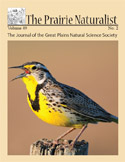Great Plains Natural Science Society

The Prairie Naturalist
Date of this Version
6-2011
Document Type
Article
Citation
The Prairie Naturalist 43(1/2):61–63; 2011
Abstract
Crayfish have an integral role in aquatic ecosystems, serving as herbivores, predators, detritivores, and prey for fishes and other aquatic and terrestrial animals (Momot 1995, Taylor et al. 1996, Martin 1997). Many crayfish populations are currently declining as a result of habitat alteration (Taylor et al. 1996) and invasive predators (e.g., rusty crayfish Orconectes rusticus [Girard; Lodge et al. 2000]). Knowledge of crayfish distribution and biology in North America and specifically North Dakota is sparse or lacking (Taylor et al. 1996) and baseline information is necessary to identify effects of anthropogenic alterations. Early inventories documented 3 crayfish species in North Dakota: calico crayfish Orconectes immunis (Hagen), virile crayfish, O. virilis (Hagen), and devil crayfish, Cambarus diogenes Girard (Harris 1903, Crocker and Barr 1968, Hobbs 1989, Taylor et al. 1996); however an extensive statewide crayfish survey with site specific information has not been conducted. Additionally, the rusty crayfish is present in the surrounding states of Minnesota and South Dakota (Olden et al. 2006) and in southern Manitoba (Phillips et al. 2009). This invasive species has been known to displace native crayfishes (Hill and Lodge 1999) and cause severe ecological alterations that can affect fishes. The rusty crayfish can limit macrophyte growth which can remove habitat and alter nutrient cycles (Hill and Lodge 1999, Byron and Wilson 2001). Our objectives were to document presence and distribution of native and non-native crayfish species in central and western North Dakota.
Included in
Biodiversity Commons, Botany Commons, Ecology and Evolutionary Biology Commons, Natural Resources and Conservation Commons, Systems Biology Commons, Weed Science Commons


Comments
Published by the Great Plains Natural Science Society. Used by permission.